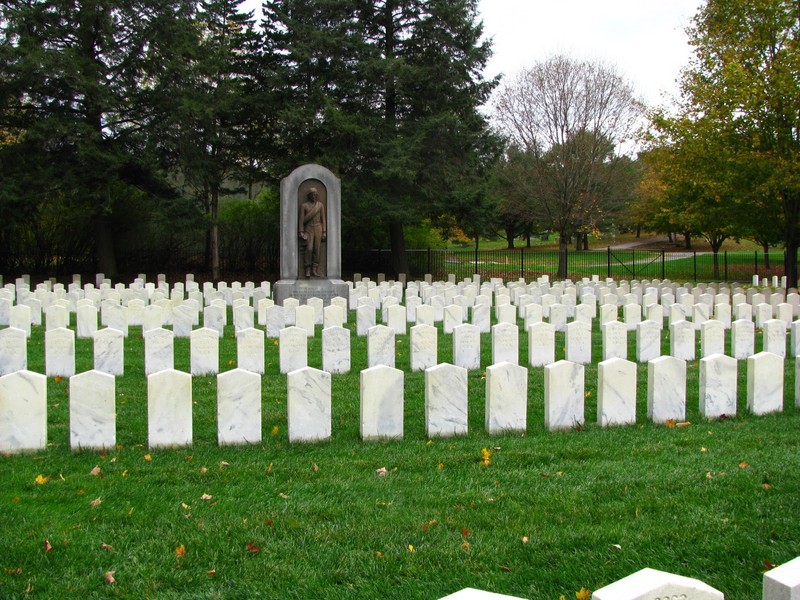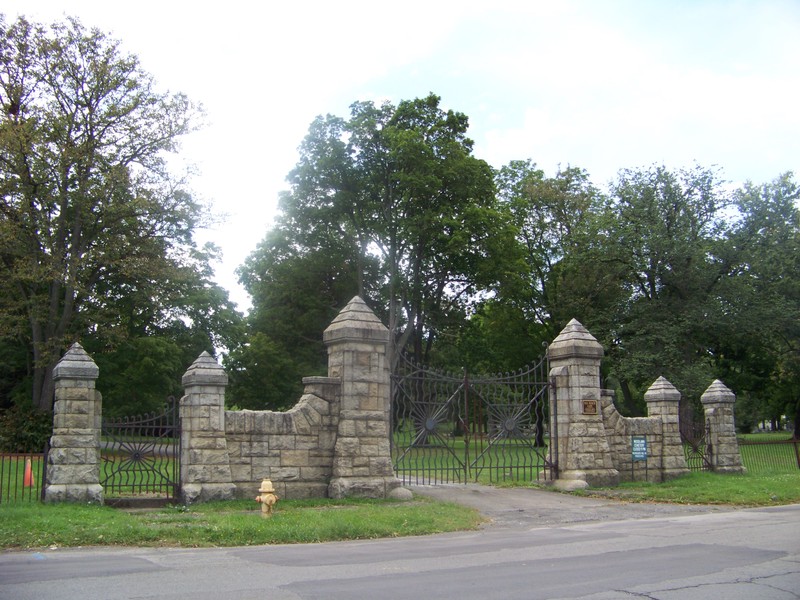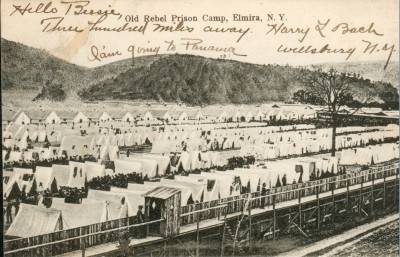Woodlawn National Cemetery
Introduction
Text-to-speech Audio
Images
A memorial to the Confederate soldiers who died while in captivity at the camp.

A general overview as to the amount of soldiers buried at the Woodlawn Cemetery.

One of the gates used to enter or exit the Woodlawn Cemetery.

A picture depicting the Elmira prison camp taken during the Civil War.

Backstory and Context
Text-to-speech Audio
Woodlawn National Cemetery
Throughout the United States, there are cemeteries built exclusively for those who served in the armed forces when the call was needed. Many of these cemeteries once served another function prior to being a resting place for fallen soldiers. One of these cemeteries, the Woodlawn Cemetery of Elmira New York is a reminder to those who not only served in the war but for those who suffered while being imprisoned during the duration of the Civil War. To be specific, during the bloody period of the American Civil War, thousands of Confederate prisoners were interned in POW camps throughout the town of Elmira which housed up to 12,000 men. During which time many suffered from the lack of adequate living conditions within said prison and as a result up to 3,000 men died at the camp until the war’s conclusion in May of 1865.
While the cemetery holds the memory of those who died during this war, the city of Elmira played an equally large role in the history of how the cemetery came into the war. “In all of New York State no other community was so immediately touched by the Civil War as was the town of Elmira.”[1] Considered a significant destination for New York’s transportation system, the village of Elmira was a bustling town which thanks to both the development of the Cheming and the Erie Canal became an important commercial center for the state, with demands for production reaching a high level. Elmira manufactured goods that included lumber, shoes, woolen goods, barrels and agricultural goods to markets in Syracuse, Buffalo, Utica, Rochester, Albany and New York City itself. It was during the 1830s and 1840s that the town saw it’s affluence grow due in part to the creation of the railroads that brought the town closer to New York City’s market in a much faster pace. Thanks to the railroad’s creation Elmira saw its industries in lumber and woolen goods expand throughout the 1840s and 1850s.
Following the news of the downfall of Fort Sumter in 1861, fervent patriotism exploded throughout the streets with its citizens calling for unity, duty and victory. “The hall was pocketed full and the blood of the people was up.”[2] The outbreak of the Civil War saw Elmira back in business as a leading producer of materials for the Union’s cause. Throughout the course of the war, Elmira served the Union in a variety of way specifically it served as a point of departure for coal which was mined out of Pennsylvania, the Pratt Woolen Mill produced 1,000 yards of cloth for the army every day. In addition to Elmira’s value as an industrial hub, it was also well known for its role as an agricultural community that produced goods such as wheat, corn, potatoes, tobacco, etc. In addition to its’ service as a source for materials, Elmira also issued troops for the Union army. Following President Lincoln’s call for 75,000 volunteers from several counties including Schuyler, Tiaga, Tompkins and Steuben.
Because Elmira was so angry and spirited over the attack on Fort Sumter and because of its’ strong sense of patriotism, it was designated as a “garrison town” in which its’ efforts became dedicated to producing necessities needed for the north to win this war including soldiers. Within a month after the beginning of the war, Elmira was designated as a rallying point for the army of New York due to its’ position near the Elmira Railroad. “The journal added that the village’s east-west transportation route was the Erie Railroad ‘over which any army might role [sic] and not disturb the bar.”[3] Although it appeared as though it was ready for the task of supplying the Union and a choice of sound military logic, it was ill prepared to handle the tasks of training such large numbers of recruits in a short period of time.
Following Elmira’s establishment as a “garrison town” for the Union, it soon began to deal with mustering together men for battle let alone the war. Its recruits were comprised of mainly citizens from the town itself, particularly middle class inhabitants, white protestant farmers to working-class Irish-German Catholics and members of the higher crust of society as positions of command in the military. “In many cases, the officers, being gentlemen of manly and gallant bearing, were cordially received into the best society at Elmira.”[4]The real challenge in which the town faced on was finding a place to help quarter troops; after a series of failed attempts to establish a training post in everything from churches-to public halls and private homes; carpenters and laborers were enlisted to build the official barracks. The spot chosen for the training barracks was the fairgrounds situated along the northern shore of the Chemung River that would be completed by the end of the summer of 1861 christened as Camp Chemung. In June of that same year, the completed barracks up to six different barracks throughout the town of Elmira with well-constructed barracks, cook houses and mess houses. Overall the barracks made Elmira seem like the finest wartime facility in New York according to journalists. However, while the newly built facilities appeared to be state-of-the-art; it would soon turn out that they were instead unprepared for the task of producing and effective fighting force.
The recruits that swarmed into Elmira had never expected to be prepared for the translation they were going to undertake; they were raw, sincere, patriotic and naive. For most this was their first exposure to the military and a more regimented lifestyle as Private F.W. Baker explains, “We fare pretty well, yet we have to march about half a mile to our meals…but they all feel well and in fitting order after we get drilled there is nine thousand soldiers in place.”[5] Because the barracks were built throughout the town of Elmira, there was a constant presence of military elements in everyday life for the town as a whole. “Cornet bands and patriotic drum and fife corps … stirred the souls of the local citizenry with strains of material music by day and by night.”[6] However, the patriotic fervor which existed was merely a distraction from the troubles that plagued the camp itself. To be specific, the camp suffered from a shortage of supplies including clothing, weapons, food and medical supplies. Furthermore, the recruits were poorly trained by their supervisors that the best they could hope to be was prepared for whatever would come. Many of the Elmira recruits were sent to the battlefields of the southern theaters such as the Battle of Bull Run. Assuming an early victory for the Union on July 12th 1861the barracks were ordered by New York’s governor Morgan closes down. While the barracks closed down its doors on the assumption of a quick victory for the Union, in the aftermath of the Battle of Bull Run and upon hearing of the great number of losses on both sides, the people of the North as well as their southern counterparts came to realize how serious of a conflict this was soon to become.
Following the loss at Bull Run, President Lincoln called for a number of 500,000 volunteers to serve a three year term in the Union army. To this end, Governor Morgan called for 25,000 volunteers in New York state to action and with the arrival of an African American Buffalo regiment in Elmira, the barracks reopened their doors and the town of Elmira was again converted into a “garrison town” for the Union. Despite the fervent patriotism that existed in the town prior to the Battle of Bull Run, the reorganization of the town into a militaristic community did not sit well with a majority of the inhabitants who constantly reported acts of foul play, vandalism and raids brought on by the soldiers present there. “There were reports that one of the villages’ cemeteries was vandalized by soldiers who broke some tombstones and turned over others and one of Elmira’s three breweries was raided by a large number of recruits.”[7] Despite these problems which the city encountered, Elmira continued to function as a hub for wartime activity throughout the course of the Civil War and later a depot until it was changed into a federal draft rendezvous point in 1863. In the year 1862, the number of Union soldiers began to dwindle and with this, congress passed an ambiguous bill in July 1862 which gave Lincoln the power to call the militia of the Union states into federal service as well as the passing of the Enrollment act on March 3rd, 1863 which “commuted wealthier Americans away from the draft. To make matters worse, because there was a period of violence brought on by the troops stationed resulted in a confrontation known as the “Battle of Chemung in which six companies of the 1st Michigan regiment known as “woodchoppers” went up against companies of Barracks No 3 as a result of the acts of violence caused by the woodchoppers on February 25th 1864. Yet despite the discontent that arose from the incidents of violence brought on by some of the soldiers stationed in Elmira, the US government was not about to take it out of the equation as a military depot as a result of the violence plagued by the troops.
In the spring days of 1862, the US Commissary General of prisoners Col William Hoffman began to see the potential of the town of Elmira as a place to quarter enemy soldiers. In the days prior to the conception of this idea, Confederate soldiers interned by the Union at old forts and temporary stockades interned by the Union at old forts and temporary stockades at Ellis Island prior to its’ function as an entry point for European immigrants and Beldoe’s Island in 1864-1865 prior to its’ establishment as Liberty Island. It was also during the initial years that the Union and the Confederacy engaged in prisoner exchanges along the James River in Virginia in a location called Haxall’s Landing in what was to become known as “the Cartel.” The trades were carried out between the armies of both the Union and the Confederacy rather than the government themselves because Lincoln believed his participation would mean he recognized the legitimacy of the confederacy. However, Lincoln would eventually come to recognize the cartel but it was doomed for failure nevertheless. The real flow in the cartel was the fact that it was a tenuous document that rested upon the fragile word of the generals John A Dix of the Union and Major General Daniel H Hill of the Confederacy who were both tempered by the horrors of war. The Cartel ended in April 1863 because of the Union’s criticism of the Confederacy violating the terms of the agreement between the armies. Furthermore, Union Lieutenant General Ulysses S Grant concluded that holding Southern Prisoners would deplete the manpower of the Confederacy and that the north with its overwhelming larger population would not have to worry about the same problem happening to them. Supported by the then remaining question was where to put the Confederate prisoners? This was answered by the reports held by Colonel Hoffman of the Commissary of Prisoners given to him two years ago that went into detail about the Elmira Barracks and how they have an abundance of barracks which could provide relief for the crowed prison conditions at the Point Lookout in Maryland. After a considerable amount of debate, the town of Elmira was approved the proposition to remake the barracks into a prison camp and with this approval the Commissary General of Prisoners issued the rules and regulations for the camp on April 20th, 1864.
Following the establishment of the Elmira barracks as a prison camp, the grounds opened on July 2nd of 1864. Upon entry into the Elmira barracks, the prisoners were divided into companies of 84 men based on the circumstances of their rank, regiment and company. Each group was under the command of a commissioned Union officer who would come to serve multiple companies as the population grew. To provide the necessary supplies for a large inmate population, the prison utilized private retailers and wholesalers throughout Elmira in a period of six months at a time for items such as food, lumber, coal, firewood and clothing. In addition to the use of retailers for supplies, the prison utilized the use of prisoners, guards and clerks in positions like waiters, cooks, bakers, kitchen workers, ward sergeants and General laborers. While it appeared as if the prison had a full proof system, it had an unsanitary atmosphere present within its inner workings that would soon take a toll on all within the system.
On July 31st of the year of 1864 there occurred a raid the guardhouse and obtain shovels and picks to attempt to demolish the fence and liberate themselves. However, this breakout was put down after it was discovered by the prison staff. This breakout showed the escalation of defiance that existed within the Elmira system. The raid was coincided by the presence of epidemics regarding the unsanitary conditions that were prevalent and from the prison’s water supply derived from the local pond named Foster’s. In addition to the conditions brought on by the unsanitary state of the prisons’ interior and water supply, the prison inmates also suffered from inadequate housing, overcrowding and natural disasters. As a result of these conditions, between the final months of 1864 to the end of the war in May 1865 approximately 2,950 prisoners had died out of the 12,000 that had been interned. In terms of the manner which the prison staff buried their deceased, the US government had no plan for the burial of their prisoners of war. To settle this problem, the town of Elmira gave the prison staff permission to use one-half acres of the local Woodlawn Cemetery but was later upgraded to two and one-half acres following the conclusion of the war in May of 1865. Originally chartered by the state of New York in 1858, the cemetery was designed by prominent architect Howard Daniels who had designed several other cemeteries throughout the states of New York and Ohio as well as one of the men who had designed the layout of New York City’s Central Park. Following end of the Civil War, the prisoners were released after they were required to take a loyalty oath to the Union, with the last prisoner to leave in September 27th, 1865. Following the departure of its final prisoner, the camp shut down its’ doors and ended its run as a training place for the Union.
Following the passing of the Civil War years, the Woodlawn Cemetery remains in the same grounds as it has been in since its use as a burial for Confederate POWs. These days however the Cemetery serves as a graveyard for all American veterans even from the modern battlefields. In addition to the Cemetery being the burial site for deceased veterans, the Cemetery also serves as a burial place for several influential and iconic American figures including Mark Twain, Hal Roach and Ernie Davis. In terms of Elmira Barracks, following the camp closing its doors, the remains were torn down and converted into a farm land. Although the Camp itself is destroyed and the Civil War has long since passed, the Cemetery remains as a reminder of that dark period when the Federalist forces of the United States utilized the encampment of their own people as a means to maintain the order and unity of the United States even though it was against their own kind.
[1] Elmira Death Camp of the North, Michael Horigan, pg. 1
[2] Elmira: Death Camp of the North, Michael Horigan, pg. 6
[3] Elmira: Death Camp of the North, Michael Horigan, pg.7
[4] Elmira: Death Camp of the North, Michael Horigan, pg.8
[5] Elmira: Death Camp of the North, Michael Horigan, pg.9
[6] Elmira: Death Camp of the North, Michael Horigan, pg.9
[7] Elmira: Death Camp of the North, Michael Horigan, pg. 12.
